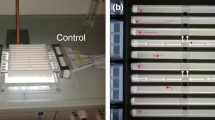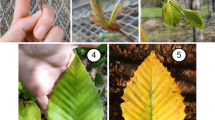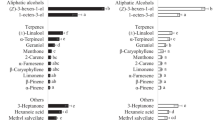Abstract
Coupled gas chromatography with electroantennographic detection (GC-EAD) using antennae of adult female Manduca sexta was employed to screen for olfactory stimulants present in headspace collections from four species of larval host plants belonging to two families: Solanaceae—Lycopersicon esculentum (tomato), Capiscum annuum (bell pepper), and Datura wrightii; and Martyniaceae—Proboscidea parviflora. Headspace volatiles were collected from undamaged foliage of potted, living plants. GC–EAD revealed 23 EAD-active compounds, of which 15 were identified by GC-mass spectrometry. Identified compounds included aliphatic, aromatic, and terpenoid compounds bearing a range of functional groups. Nine EAD-active compounds were common to all four host plant species: (Z)-3-hexenyl acetate, nonanal, decanal, phenylacetaldehyde, methyl salicylate, benzyl alcohol, geranyl acetone, (E)-nerolidol, and one unidentified compound. Behavioral responses of female moths to an eight-component synthetic blend of selected tomato headspace volatiles were tested in a laboratory wind tunnel. Females were attracted to the blend. A comparison of responses from antennae of males and females to bell pepper headspace volatiles revealed that males responded to the same suite of volatiles as females, except for (Z)-3-hexenyl benzoate. EAD responses of males also were lower for (Z)- and (E)-nerolidol and one unidentified compound. Electroantennogram EAG dose–response curves for the 15 identified EAD-active volatiles were recorded. At the higher test doses (10–100 μg), female antennae yielded larger EAG responses to terpenoids and to aliphatic and aromatic esters. Male antennae did respond to the higher doses of (Z)-3-hexenyl benzoate, indicating that they can detect this compound. On the basis of ubiquity of the EAD-active volatiles identified to date in host plant headspace collections, we suggest that M. sexta uses a suite of volatiles to locate and identify appropriate host plants.
Similar content being viewed by others
References
Adler, V. E. and Jacobson, M. 1972. Electrophysiological responses of four species of pest Lepidoptera to synthetic acetates and alcohols. J. Econ. Entomol. 65:1582–1585.
Andersen, R. A., Hamilton-Kemp, T. R., Loughrin, J. H., Hughes, C. G., Hildebrand, D. F., and Sutton, T. G. 1988. Green leaf headspace volatiles from Nicotiana tabacum lines of different trichome morphology. J. Agric. Food Chem. 36:295–299.
Baur, R., Feeny, P., and Städler, E. 1993. Oviposition stimulants for the black swallowtail butterfly: Identification of electrophysiologically active compounds in carrot volatiles. J. Chem. Ecol. 19:919–937.
Bernays, E. A. and Chapman, R. F. 1994. Host-plant Selection by Phytophagous Insects. Chapman & Hall, New York.
Buttery, R. G., Ling, L. C., and Light, D. M. 1987. Tomato leaf volatile aroma components. J. Agric. Food Chem. 35:1039–1042.
Chinta, S., Dickens, J. C., and Aldrich, J. R. 1994. Olfactory reception of potential pheromones and plant odors by tarnished plant bug, Lygus lineolaris (Hemiptera: Miridae). J. Chem. Ecol. 20:3251–3267.
Christensen, T. A., Hildebrand, J. G., Tumlinson, J. H., and Doolittle, R. E. 1989. Sex pheromone blend of Manduca sexta: Responses of central olfactory interneurons to antennal stimulation in male moths. Arch. Insect Biochem. Physiol. 10:281–291.
Cossé, A. A. and Baker, T. C. 1999. Electrophysiologically and behaviorally active volatiles of buffalo gourd root powder for corn rootworm beetles. J. Chem. Ecol. 25:51–66.
Dickens, J. C. 2000. Sexual maturation and temporal variation of neural responses in adult Colorado potato beetles to volatiles emitted by potato plants. J. Chem. Ecol. 26:1265–1279.
Gibbs, R. D. 1974. Chemotaxonomy of Flowering Plants. 4 Vols. McGill-Queen's University Press, Montreal.
Groot, A. T., Timmer, R., Gort, G., Lelyveld, G. P., Drijfhout, F. P., Van Beek, T. A., and Visser, J. H. 1999. Sex-related perception of insect and plant volatiles in Lygocoris pabulinus. J. Chem. Ecol. 25:2357–2371.
Hansson, B. S., van der Pers, J. N. C., and Löfqvist, J. 1989. Comparison of male and female olfactory cell response to pheromone compounds and plant volatiles in the turnip moth, Agrotis segetum. Physiol. Entomol. 14:147–155.
Harborne, J. B. and Turner, B. L. 1984. Plant Chemosystematics. Academic Press, New York.
Heath, R. R. and Manukian, A. 1994. An automated system for use in collecting volatile chemicals released from plants. J. Chem. Ecol. 20:593–608.
Hebets, E. A. and Chapman, R. F. 2000. Electrophysiological studies of olfaction in the whip spider Phrynus parvulus (Arachnida, Amblypygi). J. Insect Physiol. 46:1441–1448.
Henning, J. A. and Teuber, L. R. 1992. Combined gas chromatography-electroantennogram characterization of alfalfa floral volatiles recognized by honey bees (Hymenoptera: Apidae). J. Econ. Entomol. 85:226–232.
Hildebrand, J. G. 1995. Analysis of chemical signals by nervous systems. Proc. Natl. Acad. Sci. USA 92:67–74.
Hildebrand, J. G. 1996. Olfactory control of behavior in moths: Central processing of odor information and the functional significance of olfactory glomeruli. J. Comp. Physiol. A 178:5–19.
Huber, D. P. W., Gries, R., Borden, J. H., and Pierce, H. D. J. 2000. A survey of antennal responses by five species of coniferophagous bark beetles (Coleoptera: Scolytidae) to bark volatiles of six species of angiosperm trees. Chemoecology 10:103–113.
Jonsson, M. and Anderson, P. 1999. Electrophysiological response to herbivore-induced host plant volatiles in the moth Spodoptera littoralis. Physiol. Entomol. 24:377–385.
Kaissling, K. E., Hildebrand, J. G., and Tumlinson, J. H. 1989. Pheromone receptor cells in the male moth Manduca sexta. Arch. Insect Biochem. Physiol. 10:273–279.
King, J. R., Christensen, T. A., and Hildebrand, J. G. 2000. Response characteristics of an identified, sexually dimorphic olfactory glomerulus. J. Neurosci. 20:2391–2399.
Knudsen, J. T., Tollsten, L., and Bergstrom, L. G. 1993. Floral scents—a checklist of volatile compounds isolated by head-space techniques. Phytochemistry 33:253–280.
Lee, J. K. and Strausfeld, N. J. 1990. Structure, distribution and number of surface sensilla and their receptor cells on the olfactory appendage of the male moth Manduca sexta. J. Neurocytol. 19:519–538.
Light, D. M., Kamm, J. A., and Buttery, R. G. 1992. Electroantennogram response of alfalfa seed chalcid, Bruchophagus roddi (Hymenoptera: Eurytomidae) to host-and nonhost-plant volatiles. J. Chem. Ecol. 18:333–352.
Loughrin, J. H., Hamilton-Kemp, T. R., Andersen, R. A., and Hildebrand, D. F. 1990. Headspace compounds from flowers of Nicotiana tabacum and related species. J. Agric. Food Chem. 38:455–460.
Luning, P. A., Ebbenhorst, S. T., de Rijk, T., and Roozen, J. P. 1995. Effect of hot-air drying on flavour compounds of bell peppers (Capsicum annuum). J. Sci. Food. Agric. 68:355–365.
Mechaber, W. L. and Hildebrand, J. G. 2000. Novel, non-solanaceous hostplant record for Manduca sexta (Lepidoptera: Sphingidae) in the southwestern United States. Ann. Entomol. Soc. Am. 93:447–451.
Pophof, B. 1997. Olfactory responses recorded from sensilla coeloconica of the silkmoth Bombyx mori. Physiol. Entomol. 22:239–248.
Raguso, R. A., Light, D. M., and Pichersky, E. 1996. Electroantennogram responses of Hyles lineata (Sphingidae: Lepidoptera) to volatile compounds from Clarkia breweri (Onagraceae) and other moth-pollinated flowers. J. Chem. Ecol. 22:1735–1766.
Raguso, R. A. and Willis, M. A. 2002. Synergy between visual and olfactory cues in nectar feeding by naïve hawkmoths, Manduca sexta. Animal Behav. 64:685–695.
Ramachandran, R., Khan, Z. R., Caballero, P., and Juliano, B. O. 1990. Olfactory sensitivity of two sympatric species of rice leaf folders (Lepidoptera: Pyralidae) to plant volatiles. J. Chem. Ecol. 16:2647–2666.
Ramaswamy, S. B. 1988. Host finding by moths: Sensory modalities and behaviours. J. Insect Physiol. 34:235–249.
Rojas, J. C. 1999. Electrophysiological and behavioral responses of the cabbage moth to plant volatiles. J. Chem. Ecol. 25:1867–1883.
Röse, U. S. R., Lewis, W. J., and Tumlinson, J. H. 1998. Specificity of systemically released cotton volatiles as attractants for specialist and generalist parasitic wasps. J. Chem. Ecol. 24:303–319.
Rospars, J. P. and Hildebrand, J. G. 2000. Sexually dimorphic and isomorphic glomeruli in the antennal lobes of the sphinx moth Manduca sexta. Chem. Senses 25:119–129.
Røstelien, T., Borg-Karlson, A.-K., Fäldt, J., Jacobsson, U., and Mustaparta, H. 2000a. The plant sesquiterpene germacrene D specifically activates a major type of antennal receptor neuron of the tobacco budworm moth Heliothis virescens. Chem. Senses 25:141–148.
Røstelien, T., Borg-Karlson, A.-K., and Mustaparta, H. 2000b. Selective receptor neurone responses to E-β-ocimene, β-myrcene, E,E-α-farnesene and homo-farnesene in the moth Heliothis virescens, identified by gas chromatography linked to electrophysiology. J. Comp. Physiol. A 186:833–847.
Sanes, J. R. and Hildebrand, J. G. 1976. Structure and development of antennae in a moth, Manduca sexta. Dev. Biol. 51:282–299.
Schoonhoven, L. M., Jermy, T., and van Loon, J. J. A. 1998. Insect-Plant Biology: From Physiology to Evolution. Chapman & Hall, New York.
Shields, V. D. C. and Hildebrand, J. G. 1999a. Fine structure of antennal sensilla of the female sphinx moth, Manduca sexta (Lepidoptera: Sphingidae). I. Trichoid and basiconic sensilla. Can. J. Zool. 77:290–301.
Shields, V. D. C. and Hildebrand, J. G. 1999b. Fine structure of antennal sensilla of the female sphinx moth, Manduca sexta (Lepidoptera: Sphingidae). II. Auriculate, coeloconic, and styliform complex sensilla. Can. J. Zool. 77:302–313.
Shields, V. D. C. and Hildebrand, J. G. 2001. Responses of a population of antennal olfactory receptor cells in the female moth Manduca sexta to plant-associated volatile organic compounds. J. Comp. Physiol. A 186:1135–1151.
Struble, D. L. and Arn, H. 1984. Combined gas chromatography and electroantennogram recording of insect olfactory responses, pp. 161–178, in H. E. Hummel and T. A. Miller (Eds). Techniques in Pheromone Research. Springer-Verlag, New York.
Thiéry, D. and Visser, J. H. 1986. Masking of host plant odour in the olfactory orientation of the Colorado potato beetle. Entomol. Exp. Appl. 41:165–172.
Tichenor, L. H. and Seigler, D. S. 1980. Electroantennogram and oviposition responses of Manduca sexta to volatile components of tobacco and tomato. J. Insect Physiol. 26:309–314.
Topazzini, A., Mazza, M., and Pelosi, P. 1990. Electroantennogram responses of five Lepidoptera species to 26 general odourants. J. Insect Physiol. 36:619–624.
Tumlinson, J. H., Brennan, M. M., Doolittle, R. E., Mitchell, E. R., Brabham, A., Mazomenos, B. E., Baumhover, A. H., and Jackson, D. M. 1989. Identification of a pheromone blend attractive to Manduca sexta (L.) males in a wind tunnel. Arch. Insect Biochem. Physiol. 10:255–271.
van der Pers, J. N. C. 1981. Comparison of electroantennogram response spectra to plant volatiles in seven species of Yponomeuta and in the tortricid Adoxophyes orana. Entomol. Exp. Appl. 30:181–192.
van Loon, J. J. A., Frentz, W. H., and van Eeuwijk, F. A. 1992. Electroantennogram responses to plant volatiles in two species of Pieris butterflies. Entomol. Exp. Appl. 62:253–260.
Visser, J. H. 1988. Host-plant finding by insects: Orientation, sensory input and search patterns. J. Insect Physiol. 34:259–268.
Visser, J. H., Piron, P. G. M., and Hardie, J. 1996. The aphids' peripheral perception of plant volatiles. Entomol. Exp. Appl. 80:35–38.
Waldrop, B. R., Harrow, I. D., Kovelman, R., and Hildebrand, J. G. 1986. Olfactory guided oviposition in the moth Manduca sexta: Host-plant preference and induction. Soc. Neurosci. Abs. 12:41.
Weissbecker, B., Schütz, S., Klein, A., and Hummel, H. E. 1997. Analysis of volatiles emitted by potato plants by means of a Colorado beetle electroantennographic detector. Talanta 44:2217–2224.
Weissbecker, B., van Loon, J. J. A., and Dicke, M. 1999. Electroantennogram responses of a predator, Perillus bioculatus, and its prey, Leptinotarsa decemlineata, to plant volatiles. J. Chem. Ecol. 25:2313–2325.
Weissbecker, B., van Loon, J. J. A., Posthumus, M. A., Bouwmeester, H. J., and Dicke, M. 2000. Identification of volatile potato sesquiterpenoids and their olfactory detection by the two-spotted stinkbug Perillus bioculatus. J. Chem. Ecol. 26:1433–1445.
Yamamoto, R. T., Jenkins, R. Y., and Mcclusky, R. K. 1969. Factors determining the selection of plants for oviposition by the tobacco hornworm Manduca sexta. Entomol. Exp. Appl. 12:504–508.
Zhang, A. J., Linn, C., Wright, S., Prokopy, R., Reissig, W., and Roelofs, W. 1999. Identification of a new blend of apple volatiles attractive to the apple maggot, Rhagoletis pomonella. J. Chem. Ecol. 25:1221–1232.
Zhang, Q. H., Schlyter, F., and Birgersson, G. 2000. Bark volatiles from nonhost angiosperm trees of spruce bark beetle, Ips typographus (L.) (Coleoptera: Scolytidae): Chemical and electrophysiological analysis. Chemoecology 10:69–80.
Author information
Authors and Affiliations
Corresponding author
Rights and permissions
About this article
Cite this article
Fraser, A.M., Mechaber, W.L. & Hildebrand, J.G. Electroantennographic and Behavioral Responses of the Sphinx Moth Manduca sexta to Host Plant Headspace Volatiles. J Chem Ecol 29, 1813–1833 (2003). https://doi.org/10.1023/A:1024898127549
Issue Date:
DOI: https://doi.org/10.1023/A:1024898127549




